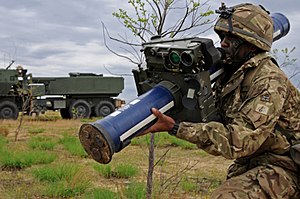| Starstreak | |
|---|---|
 A British Royal Artillery soldier protects an airfield with a man-portable Starstreak HVM system | |
| Type | Man-portable/vehicle mounted surface-to-air missile |
| Place of origin | United Kingdom |
| Service history | |
| In service | 1997–present |
| Used by | See § Operators |
| Wars | Russo-Ukrainian War |
| Production history | |
| Designed | 1980s |
| Manufacturer | Thales Air Defence |
| Produced | November 1986 |
| No. built | 7,000 |
| Variants | See § Variants |
| Specifications (Starstreak High Velocity Missile) | |
| Mass | 14 kg (31 lb)[1] |
| Length | 1.397 m (4 ft 7 in) |
| Diameter | 13 cm (5.1 in) |
| Effective firing range | Starstreak: 0.3–7 km (0.186–4.35 mi) Starstreak II: >7 km (4.35 mi)[2][3] |
| Warhead | Three explosive sub-munitions ("darts") |
| Warhead weight | 3×0.9 kg (2.0 lb) tungsten alloy darts, 450 g (16 oz) PBX-98 per dart |
Detonation mechanism | Impact delay |
| Engine | First stage: Royal Ordnance 'Brambling' cast double-based propellant blip rocket motor. Second stage: Royal Ordnance 'Titus' cast double-based propellant |
| Flight ceiling | 7 km (22,966 ft) |
| Maximum speed | More than Mach 3 at second stage burnout[4][3] |
Guidance system | SACLOS, Laser-beam guidance |
Starstreak is a British short-range surface-to-air missile that can be used as a man-portable air-defence system (MANPADS) or used in heavier systems. It is manufactured by Thales Air Defence (formerly Shorts Missile Systems) in Belfast, Northern Ireland. It is also known as Starstreak HVM (High Velocity Missile). After launch, the missile accelerates to more than Mach 4,[4][3] making it the fastest short-range surface-to-air missile in existence.[5] It then launches three laser beam-riding submunitions, increasing the likelihood of a successful hit on the target. Starstreak has been in service with the British Army since 1997. In 2012 Thales relaunched the system as ForceSHIELD.[5]
- ^ "Precision guidance with immunity to countermeasures" (PDF). Archived from the original (PDF) on 2016-03-04. Retrieved 2015-11-01.
- ^ "Starstreak II". thalesgroup.com. Archived from the original on 2016-03-05.
- ^ a b c "Starstreak II > High Velocity Missile (HVM)" (PDF). Archived from the original (PDF) on 2016-01-08. Retrieved 2015-10-23.
- ^ a b "Starstreak – CLOSE AIR DEFENCE MISSILES". Defence Journal. January 1999. Archived from the original on 25 March 2023. Retrieved 24 March 2022.
- ^ a b Cite error: The named reference
DN20140114was invoked but never defined (see the help page).